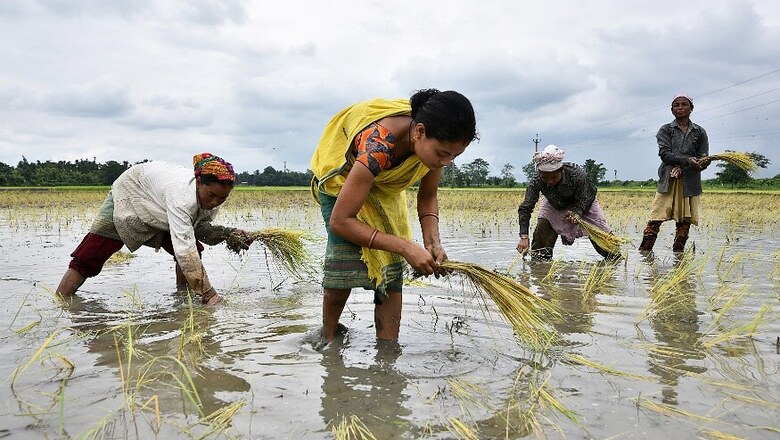
views
New Delhi: In the midst of a water crisis and spurt in fragmentation of landholdings, India’s agriculture industry is at a turning point– one that will decide the fate of the country’s food policy and its recovery from the economic slowdown.
While experts have rallied for the need to go from ‘grow more food’ to ‘grow more variety of food’, in reality, agri-business is obsessed with the incentivisation of certain cropping patterns. For over 50 years, since the green revolution, the unaccounted push for increased production has raised the farmer’s costs of cultivation. It has also disrupted the availability of groundwater. If that wasn’t enough, the farmer today is also held inside the vicious cycle of credit.
In an interview to News18, Dr Prakash Bakshi, former chairman of National Bank for Agriculture and Rural Development (NABARD) describes the dire state of Indian agriculture.
His contributions to agriculture include the designing and leading the implementation of the internationally acclaimed self-help group (SHG) programme, leading the restructuring of rural cooperatives and designing the Kudumbashree anti-poverty programme for the Government of Kerala. Presently, he is associated with the Pune based-Audyogik Shikshan Mandal (ASM) Group of Institutes.
With increasing land fragmentation, there is no water for irrigation, but increasing net area under irrigation and decreasing landholding size: where is Indian agriculture headed?
The most important structural issue with agriculture today is land fragmentation. By now there are more than 145 million landholdings in the country. By 2040, this will be close to 200 million. If you look at our total crop area, it is 150 million hectares. This means that in another 15 years the average landholding size will become less than 1 hectare. This is a huge crisis.
When land holdings become small, the farmer's requirement for input also becomes smaller. From the supply side, it becomes a bigger challenge because of the quantities involved. For example, in 100 hectares of wheat being cultivated, the amount of seeds required is the same, whether it is cultivated by one person or a hundred persons.
But from the seed seller’s point of view, if he has to sell seeds for a 100-hectare farm to one person, it is very different than selling to 100 persons. Here the cost and strategy of selling changes. The same is true for the supply of electricity. For one 100 hectares, there is one connection, while for 100 one hectare farms there are 100 connections.
What I am trying to point out is that because of land fragmentation, the cost of supplying inputs is increasing drastically and not just the price of input.
How should the agriculture sector readjust according to the current water crisis?
The policy of providing things for free to the farmer needs to be revisited.
Even if we use all the groundwater and all the surface water, we must remember that close to 30 per cent of our farms still remain unirrigated. We don’t have that much water. This means that we need to start emphasising on water-saving devices. Productivity needs to focus attention from quintals per hectare but also in quintals per cubic metre of water used.
Some steps have been taken in that direction but they are not enough. For instance, in the previous budget, it was mandatory that drip irrigation is used for the farming of water-intensive crop sugarcane.
However, the intention of certain governments to take a populist approach to agriculture has also caused problems around water. For the farmer, if he gets free electricity, he will not care about the pumps running all the time and throwing water into the fields. When there is a cost to a facility, people become more conscious.
Does waving interest on loans help or is the farmer in need of some other waivers or benefits?
I strongly oppose the concept of interest or loan waivers. As a policy, this is a wrong practice. Credit is only a small part of the bigger picture, while interest on credit is not even 10 per cent of the total cost of cultivation.
The problem then lies with land fragmentation. As the land becomes smaller and smaller, the total produces that the farmer has also become smaller vis a vis the cost of cultivation which includes the expenditure of transportation, marketing and selling of produce. What the farmer needs is good marketing.
I have been asking for three urgent reforms for the agriculture sector. One, the land leasing policy. It must be ruled that agriculture land is allowed to be leased out. Irrespective of whether the owner himself cultivates it or not, he cannot ask his neighbour or friend or someone else to cultivate it on lease.
Two, reforms are required at the Agriculture Produce Marketing Committee (APMC) Act. In most states, agricultural produce can only be sold at the mandi recognised by the APMC Act of the state. If a farmer wants to sell his produce to the prospective client directly, why can’t he sell it? Why should someone else get a mandi fee or commission on that transaction? We urgently need to change the marketing practices of his produce.
Three, Indian agriculture must move away from its focus on food grain policy. We adopted this when there was a crisis of food in the country. Now, we must endeavour to produce non-food grain crops, especially those that consume less water. We have neglected horticulture, fruits, and vegetables. This will increase the nutritional status of the country and also raise the farmer’s income. We must ask why MSP only for wheat, why not for tomato?
Can the government have sponsored skill-based agri-courses boost agri-entrepreneurship in India?
We need to start telling our farmers how to cultivate crops in other more innovative ways. We have to start telling them about vertical agriculture. We have to teach them how to use water more efficiently. This education should be given in general agricultural courses.
Agri-business is equally important for both the farmer and the increasing younger population of the country. It is important to teach our farmers how to maintain quality while producing in quantity. It is easier to maintain quality in large land holdings than smaller ones for the same quantity produced. For exports to many countries, for instance, there should be no use of fertilisers and pesticides; it should be residue-free.
Now, what is residue-free in agriculture? Are we teaching this to the aspirant MBAs in agriculture lot, are we teaching this to farmers? These are important things now. There has to be a shift in education policy from just growing more food, whether, in terms of quality, logistics, marketing or education, it is needed now.
The government can push agribusiness-education on a large scale. The HRD ministry ought to sit down with Agri ministry and see how we can impact agri-business education to the youth and farmers in colleges. We must learn from the farmer. The courses must provide skills and knowledge on cold chain, storage, logistics, cropping patterns, water efficiency that the industry demands. We must push for practical knowledge. It is time to move away from only theoretical knowledge.




















Comments
0 comment